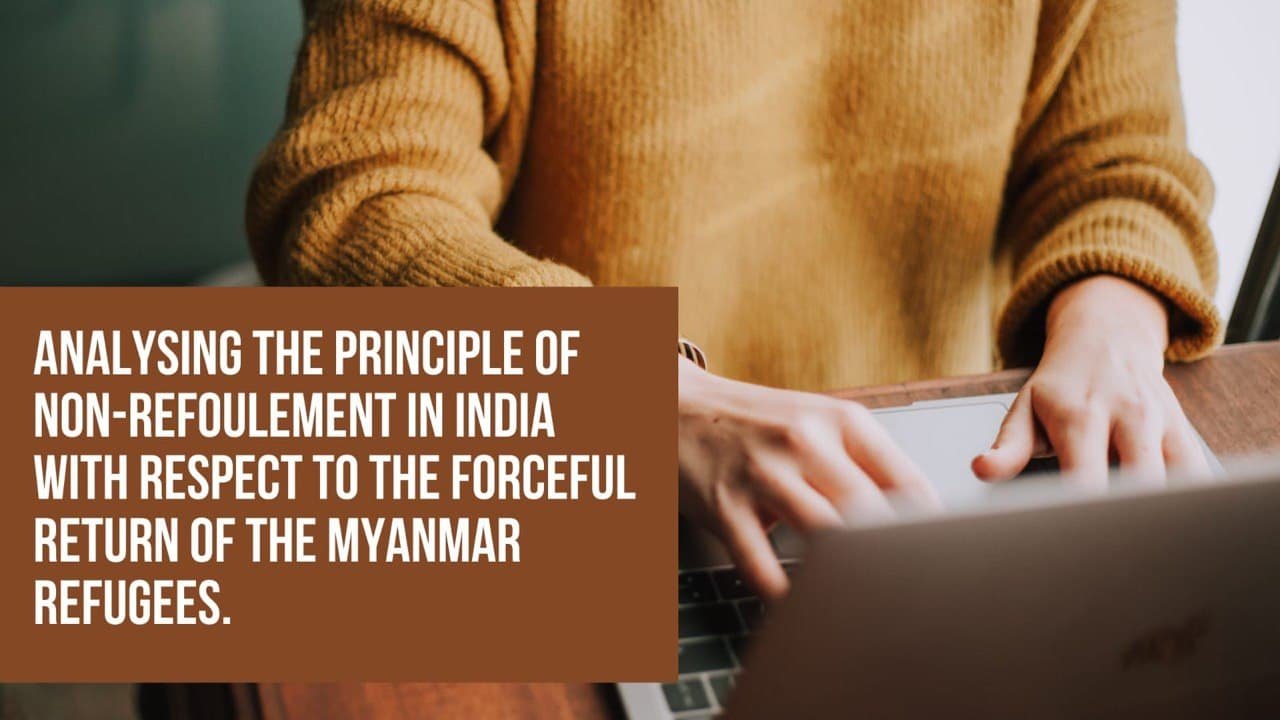“ANALYSING THE PRINCIPLE OF NON-REFOULEMENT IN INDIA WITH RESPECT TO THE FORCEFUL RETURN OF THE MYANMAR REFUGEES”.
India is a non- signatory to the Convention on the status of refugees, 1951 and also to the 1967 Protocol for the protection for the refugees, yet India has largely followed International norms and, it has time and forth come forward to help the refugees in crisis. The principle of non-refoulement was formulated to provide for safeguards to such persons, and it puts forth the idea that the states are under an obligation to not send back the refugees to their country of origin when grave violations of human rights are persisting over there.

INTRODUCTION
‘Refouler’ has been defined as ‘to drive back or to repel, as of an enemy who fails to breach
ones’ defences’. It can be said that the principle of non-refoulement is the very basis or
foundation of international law and human rights law. The term refugee has not been provided
for anywhere in any Indian statute and thus, it is a synonym of various conflicting situations
particularly in the Indian context. Refugees are subjected to social, economic, mental and
psychological trauma. The principle of non-refoulement was formulated to provide for
safeguards to such persons, and it puts forth the idea that the states are under an obligation to not
send back the refugees to their country of origin when grave violations of human rights are
persisting over there. The idea of this principle is in consonance with the customary international law and other conventions related to refugees.
India is a non- signatory to the Convention on the status of refugees, 1951 and also to the 1967
Protocol for the protection for the refugees, yet India has largely followed international norms
and, it has time and forth come forward to help the refugees in crisis. Indian scholars have
contended that the right of non- refoulement is present in India even without India having signed
any related International agreements. However in recent times it has been seen that the situations
have demonstrated otherwise also, when Rohingyas were sent back to their country and very
recently, the people who came to save themselves from Myanmar Coup were prohibited from
entering the country .
As there is absence of specific domestic laws relating to refugees in India, it becomes a
complicated process to ascertain the applicability of the principle of non-refoulement in the present context. This paper tries to delve into unresolved issues such as why India has not signed
the various Refugee Conventions, while having been a graceful host to the refugees why has it
turned away the Myanmar Coup affected citizens and the Rohingyas, can this be termed as a
gross violation of human rights and a willful deviation from the international customary law and
how the absence of domestic laws relating to refugees have an impact upon these situations.
BACKGROUND
The refugee rights regime in the modern times exists by the virtue of the 1951 Convention
Relating to the Rights of Refugees. The Convention prescribes a protocol within the participating
states must extend to refugees seeking protection within protection.
The Convention firstly, defines “refugee” and secondly, the treaties establish the rights of those
who are considered as “refugee”. To be termed as “refugee” under the convention, the person
must not just “flee to a foreign country...to escape ... the persecution”, however the person
specifically must seek to avoid harm that is inflicted for race, religion, nationality, social group
or political opinion.
Thus, it can be seen that there is a difference between usages of the term “refugee” in general versus legal parlance and the same can have profound outcomes on refugee
outcomes as people who may flee from a country due to famine, natural disaster or economic
collapse may not be considered as refugees under legal parlance. However, India has not signed
the Convention till date and the possible reasons behind the same can be ascertained due to the
comprehensive set of rights which have been accorded by the Convention fearing that it may
possibly lead to damage to domestic resources severely.
Refugee rights under the Convention and the Protocol consists of two primary components, first,
non – refoulement and second, secondary rights which exists for the daily lives of the refugees,
such as education, right to hold property, etc. This paper focuses upon the basic right of non-
refoulement.
NON REFOULEMENT AS CUSTOMARY INTERNATIONAL LAW
This principle has been adopted by the International Community by consensus as the
humanitarian basis for need of protection of refugees is felt all across the globe. To understand
whether non – refoulement can be considered as an international custom, two important
components come into picture here, first is consistent state practice and the other is opinio juris.
It needs to be shown that the practice has been adopted by the states for a considerable period of
time.
As Refugee convention is not the only international agreement protecting the rights of Refugees,
whether non-refoulement is a peremptory norm is not solely dependent upon it. Human Rights
treaties prohibit refoulement. Among international human rights treaties, the Convention Against
Torture and Other Cruel, Inhuman, or Degrading Treatment or Punishment (Torture Convention)
has been an important safeguard against refoulement. The Torture Convention states that states-
parties may not “expel, return (‘refouler’) or extradite a person to another State where there are
substantial grounds for believing that he would be in danger of being subjected to torture”.
Moreover, the Torture Convention does not permit any exceptions to its principle of non-
refoulement.
Thus, unlike the Refugee Convention and Protocol, the Torture Convention accepts
non-refoulement as a mandatory, non-derogable, and illimitable obligation that applies at all
times and in all contexts. Hence, it can be said that even if India is not a signatory to the 1951
Convention, it does not absolve it from the commitment to humanitarian protection of the
refugees. India is a signatory to the Universal Declaration of Human Rights (UDHR) 1948 and
has joined the International Convention on Civil and Political Rights (ICCPR 1966) and
International Convention on economic, social and cultural rights (ICESCR- 1966). Moreover, it
is also a signatory to the Convention on the elimination of all forms of racial discrimination
(CERD – 1965) and the Torture Convention, 1984.
Article 14 A of the UDHR states: "Everyone has the right to seek and enjoy in other countries
asylum from persecution”.
Article 13 of the ICCPR, 1966 states: "An alien lawfully in the territory of a state party to the
present Covenant may be expelled there from only in pursuance of a decision reached in accordance with law and shall, except where compelling reasons of national security otherwise require, be allowed to submit the reasons against his expulsion and to have his case reviewed by, and be represented for the purpose before, the competent authority or a person or persons especially designated by the competent authority.”
Article 3 of the Torture Convention, 1984 states “No state party shall expel, return (“refouler”)
or extradite a person to another state where there are substantial grounds for believing that he
would be in danger of being subjected to torture”. The above provisions indicate that India is
obligated to secure the rights of non – refoulement conferred upon refugees.
Most of the scholars have over the time concluded that non refoulement comes under the ambit
of customary international law and prohibits refoulement of any persons who would qualify for
protection under the 1951 Convention, the Refugee Protocol and the Torture Convention.
However, in the recent past we have seen deviations from the conventions and protocol as well.
Cathryn Castello and Michelle foster have argued for the favour of conception of non-
refoulement as a premeptory norm of International Law. In their work, Cathyrn and Michelle
have applied a “customary international law plus” theory, according to which customary norms
qualify as jus cogens if states have manifest widespread support for the norm having this
distinctive status of a peremptory norm. They surveyed multilateral treaties, U.N. General
Assembly resolutions, Executive Committee conclusions, and other evidence of state practice
and opinio juris, Costello and Foster have tried to convince their readers over the point that the
principle of non-refoulement has become firmly embedded in customary international law.
Costello and Foster then lean heavily on General Assembly resolutions and Executive Committee conclusions to establish that states now accept non-refoulement as a peremptory norm. However, there are other skeptics that argue on the other side and state that legal experts are yet to reach a consensus regarding whether the principle can be accepted under international customary law. Thus, the quest regarding terming non-refoulement as a customary international law stands unresolved as of now.












